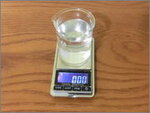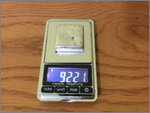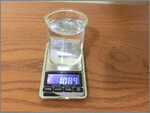This is a method for calculating the Tin/Lead content in any solder containing mainly those two metals. The method uses only a scale to precisely determine the density of the solder and from there knowing the density of the Tin and Lead, to calculate the Tin/Lead ratio.
As you know the best solder has a Tin/Lead ratio anywhere from 60/40 to 67/33. I had some bad solder with low tin content and I decided to add pure tin to improve it, but first I needed to know how much Tin and Lead it has. If you want to test your solder for precisely how much Tin and Lead it has, you can use the following simple method, all you need is a weight scale with high precision (I am using one with 0.01gr precision).
Step1:
- Melt the solder and make a small bullion - the shape is not important, however it should fit in a small glass without touching the walls.
Step2:
- Weight the bullion. My initial test was with 10gr bullion, but I am showing now the final result of the improved solder - a 92.21gr bullion.

Step3:
- Place a glass of water on the scale and tare (zero) the scale.

Step4:
- On a very thin thread immerse the bullion in the water without touching the walls or the bottom and write the weight that the scale is showing. In my case the scale shows 10.89gr - this is the buoyant force.

Step5:
Calculations:
- Using the Archimedes' principle we are going to calculate the volume of the bullion from the buoyant force. Assuming room temperature then the density of the water is 0.999gr/cm3 - so my Volume of the bullion is the buoyant force/0.99, hence:
Volume = 10.89/0.99 = 11.00cm3
- Now knowing the Volume (V=11.00 cm3), the Weight (W=92.21 gr) and densities of the Tin (7.365 gr/cm3) and the Lead (11.34 gr/cm3) we can make the following two linear equations for our bullion:
W = mSn + mPb
V = (mSn/qSn) + (mPb/qPb)
mSn = the weight of the tin content
mPb = the weight of the lead content
qSn = the density of the tin
qPb = the density of the lead
Sn = tin
Pb = lead
thus when we put the numbers it looks like:
92.21 = mSn + mPb
11.00 = (mSn/7.365) + (mPb/11.34)
We can easily solve those two equations and what I get for mSn and mPb is:
mSn = 60.27 gr
mPb = 31.94 gr
Hence 65% Tin and 35% Lead or I made 65/35 solder(1) - :clap:
(1) Once when you have determined the Tin/Lead ratio in any solder you can easily calculate exactly how much pure Tin (or Lead) you have to add to a given weight to make a new ratio of Tin/Lead.
As you know the best solder has a Tin/Lead ratio anywhere from 60/40 to 67/33. I had some bad solder with low tin content and I decided to add pure tin to improve it, but first I needed to know how much Tin and Lead it has. If you want to test your solder for precisely how much Tin and Lead it has, you can use the following simple method, all you need is a weight scale with high precision (I am using one with 0.01gr precision).
Step1:
- Melt the solder and make a small bullion - the shape is not important, however it should fit in a small glass without touching the walls.
Step2:
- Weight the bullion. My initial test was with 10gr bullion, but I am showing now the final result of the improved solder - a 92.21gr bullion.
Step3:
- Place a glass of water on the scale and tare (zero) the scale.
Step4:
- On a very thin thread immerse the bullion in the water without touching the walls or the bottom and write the weight that the scale is showing. In my case the scale shows 10.89gr - this is the buoyant force.
Step5:
Calculations:
- Using the Archimedes' principle we are going to calculate the volume of the bullion from the buoyant force. Assuming room temperature then the density of the water is 0.999gr/cm3 - so my Volume of the bullion is the buoyant force/0.99, hence:
Volume = 10.89/0.99 = 11.00cm3
- Now knowing the Volume (V=11.00 cm3), the Weight (W=92.21 gr) and densities of the Tin (7.365 gr/cm3) and the Lead (11.34 gr/cm3) we can make the following two linear equations for our bullion:
W = mSn + mPb
V = (mSn/qSn) + (mPb/qPb)
mSn = the weight of the tin content
mPb = the weight of the lead content
qSn = the density of the tin
qPb = the density of the lead
Sn = tin
Pb = lead
thus when we put the numbers it looks like:
92.21 = mSn + mPb
11.00 = (mSn/7.365) + (mPb/11.34)
We can easily solve those two equations and what I get for mSn and mPb is:
mSn = 60.27 gr
mPb = 31.94 gr
Hence 65% Tin and 35% Lead or I made 65/35 solder(1) - :clap:
(1) Once when you have determined the Tin/Lead ratio in any solder you can easily calculate exactly how much pure Tin (or Lead) you have to add to a given weight to make a new ratio of Tin/Lead.


